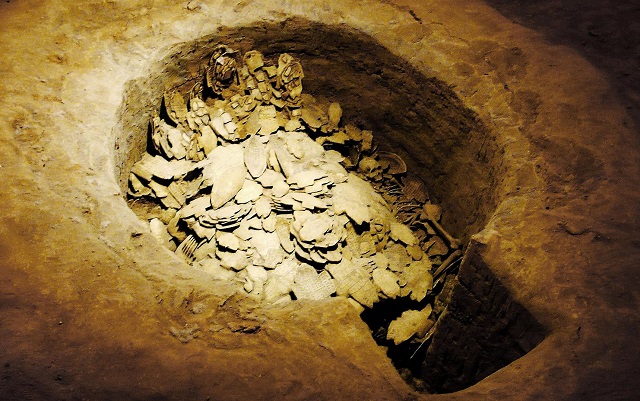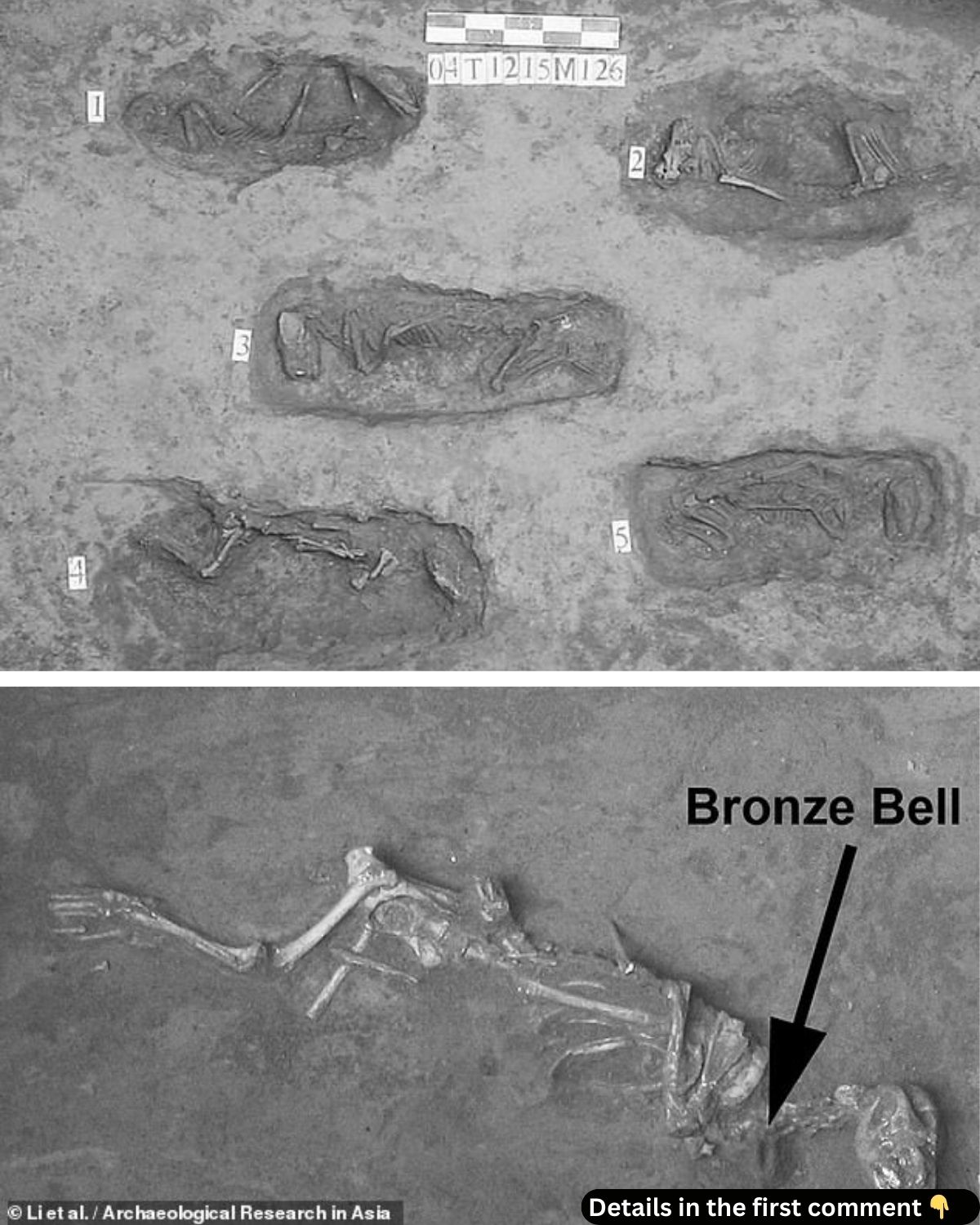The Shang Dynasty, one of ancient China’s most enigmatic periods, is known for its complex rituals and beliefs. Among the most striking discoveries are the sacrificial practices involving dogs—specifically puppies—during this Bronze Age civilization. These sacrificial acts reveal not only the spiritual beliefs of the time but also the harsh realities of survival and social hierarchy. Recent findings from archaeological sites have unearthed startling details about these rituals, shedding light on the intersection of religion, economics, and power in Shang society.
Uncovering the Remains of Sacrificial Dogs in Zhengzhou
In the ancient city of Zhengzhou, excavations have revealed the chilling evidence of animal sacrifice, where archaeologists uncovered eight carefully-dug pits—four oval and four rectangular. Within these pits lay the skeletal remains of 92 dogs, arranged in a manner that suggested they had been bound and buried alive.
The discovery of these ritualistic dog burials offers a glimpse into the complex sacrificial traditions of the Shang Dynasty, where the elite class often used animals to secure favor from the gods. This practice of tying up and burying the dogs alive highlights the profound symbolism behind these rituals, where the act of sacrifice may have been seen as a powerful offering to the divine.


Video
Check out this video to discover the intricate tigers, dragons, and monsters depicted on a Shang Dynasty ewer, offering a glimpse into ancient Chinese artistry and symbolism.
The Role of Dogs in Shang Dynasty Rituals
The Shang Dynasty, which ruled from 1600 to 1046 BCE, was known for its elaborate and often violent religious rituals, which involved both human and animal sacrifices. Dogs, particularly puppies, were frequently used in these ceremonies, with many being buried in pits alongside the deceased or within the tombs of the elite.
These sacrificial dogs were not merely pets; they were seen as spiritual intermediaries, offering their lives to appease the gods and ensure the safety of the deceased in the afterlife. The presence of puppies in these sacrificial rites suggests that they were chosen for their symbolic value rather than their maturity, with younger animals possibly being seen as more suitable for the role of an offering.
Dogs as Surrogates for Human Sacrifice
Interestingly, the use of dogs in these rituals may have been a more economical alternative to human sacrifices, which were also a common practice among the Shang elite. While human sacrifices were typically reserved for important rituals, such as those performed for rulers or in the context of war, dogs might have been used as substitutes.
By sacrificing puppies—an easily accessible and less costly option—the Shang elite could continue their sacrificial practices without the need for human victims. This theory is further supported by the fact that many of the dogs found in the pits were under one year old, suggesting that they were not beloved pets but rather animals raised specifically for sacrificial purposes.
The Significance of Dog Sacrifices in Shang Beliefs
Dogs held a unique place in the Shang worldview, occupying a space between the human and animal realms. Unlike livestock, such as pigs and cattle, which were primarily used for food, dogs were imbued with a special spiritual significance. Their role in sacrificial rituals likely stemmed from their symbolic association with loyalty, protection, and strength—traits that were valued by the Shang elite. By offering dogs to the gods, the Shang elites may have believed they were ensuring their own safety and favor in the afterlife, much like how they used human sacrifices to honor their ancestors and deities.
Puppies as Stand-Ins for Guard Dogs and Humans
The idea that puppies were used as a symbolic substitute for adult guard dogs is a compelling one. In many ways, the young dogs could be seen as miniature versions of the real thing, offering the same symbolic protection without the need for a fully grown animal.
This practice of using puppies in sacrificial rites could also be compared to the use of miniaturized goods, such as fake bronzes or ceramics, which were sometimes buried with the dead. Just as these objects were symbolic stand-ins for more valuable items, puppies may have served as stand-ins for more mature guard dogs or even human sacrifices, reflecting the Shang’s penchant for symbolism in their rituals.

The Economic and Cultural Context of Dog Sacrifice
The use of puppies in Shang sacrificial rituals was not just a matter of religious practice but also reflected the economic realities of the time. Raising and sacrificing puppies was a more affordable option compared to raising fully grown dogs or offering human lives. It is possible that the Shang elite had access to large numbers of dogs specifically bred for sacrificial purposes.
Alternatively, stray dogs may have been rounded up for these rituals, making them an even more economical choice. The practice of dog sacrifice, then, was likely shaped by both religious beliefs and practical considerations, ensuring that the needs of the elite could be met without undue cost.
The Continued Importance of Dog Sacrifice
Even as the Shang Dynasty came to a close, the practice of dog sacrifice remained a significant tradition. Inscriptions found on oracle bones—the remains used for divination—suggest that the sacrifice of dogs continued well into the late Shang period. These sacrifices were likely performed to honor the gods of the sky, ensuring divine favor for the Shang rulers and their people. The persistence of dog sacrifices during this period highlights the deep-rooted nature of these rituals in Shang society, where animals were seen not just as creatures to be consumed or utilized but as integral components of spiritual life.
Reevaluating Shang Rituals and Practices
While the study of Shang sacrificial practices has traditionally focused on the elite and their burial rites, recent archaeological findings have prompted scholars to consider the broader societal context of these rituals. The widespread use of dogs in sacrificial practices raises questions about the role of animal sacrifice in the lives of ordinary Shang people.
Were these rituals practiced by rural communities as well as the elite? How did these sacrifices shape the cultural and social fabric of Shang society? As new discoveries continue to emerge, these questions offer valuable opportunities for further exploration of the Shang Dynasty’s complex belief system and its enduring influence on Chinese culture.
Video
Tune into this video from Smithsonian Channel to see how a 3,000-year-old oracle bone helps reveal the story of a Shang Dynasty queen, offering new insights into ancient China.
Conclusion: The Ritual Legacy of Dog Sacrifice in the Shang Dynasty
The ritual sacrifice of dogs during the Shang Dynasty offers a fascinating window into the spiritual and cultural practices of ancient China. Through archaeological discoveries, we can better understand the symbolic role that these animals played in the lives of the Shang elite, serving as both offerings to the gods and representations of strength and protection in the afterlife.
The use of puppies in these rituals, while seemingly cruel by modern standards, was deeply embedded in the religious and economic context of the time. As we continue to uncover new evidence from Shang sites, the practice of dog sacrifice remains a powerful reminder of the complex relationship between humans and animals in ancient societies.



